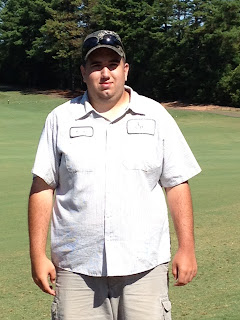Speaking of too wet, one thing I hear most often from members during periods of extended wet weather is, "You must be loving all this rain?". The answer may surprise you, not exactly. Let me explain. When it comes to management of bentgrass putting greens in the humid southeast, the best case scenario for overall plant health in the summer is dry or near draughty conditions (this is assuming hot is a given). When this is the case I have the ability to control the moisture the plant receives via our irrigation system and hand watering practices. We are better able to manage the greens and prevent them from becoming too wet during periods of extremely hot weather leading to better quality putting surfaces (this is representative of the conditions we were enjoying all of June and right up through the extremely hot weekend prior to my last post).
Beginning on July 3rd and continuing for most of that week the temperatures dropped back into the mid to upper 90's with higher levels of humidity. Turf diseases are most prevalent during hot and humid conditions with the real culprit being the humidity because the moist conditions provide the right environment for fungal growth. During periods of hot and wet conditions such as experienced the past three days the over abundance of soil moisture can cause root zone temperatures to increase to levels detrimental to bentgrass roots. Also, the over abundant supply of water in the root zone displaces oxygen leading to anaerobic conditions which causes bentgrass turf to decline leading to a severe thinning of the canopy and otherwise "yucky" conditions. In other words, all this rain lately (severe thunderstorm rain) only makes the bermudagrass green and helps fill up the lake. It is not a cool, slow soaking rain that would be most beneficial to the health of our putting surfaces and that is why I am not always happy when it rains...and my wife thinks I am crazy!
In other news, you may have noticed a certain red oak tree located on the right side of number four near the cart path. The tree appears to be dying as one side of its canopy has turned brown.
 |
| Leaf Scorch |
Also, I mentioned some things last time about the seasonal staff and already I have endured two more desertions (Igor and Marin). At this time we have 5 seasonal employees present and we are waiting for number 6 to arrive either tomorrow or the next day. We have suffered 5 defections total this season and quite frankly frustrated does not begin to describe what I am experiencing. I am not going to mention names or promise pictures at this time but if things work out with these newer guys I will post at a time I feel is appropriate. If you would like to learn more about this issue and the potential reasons I am being told are responsible I will be happy to discuss with you if asked. I will mention this problem is widespread this year and we are by no means the only golf course affected.
See you on the course,
Matthew Wharton
Golf Course Superintendent



